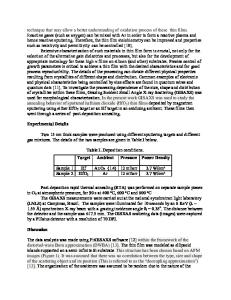Annealing Behavior of Ba 2 Ycu 3+X O 7+Y Thin Films
- PDF / 148,977 Bytes
- 3 Pages / 420.48 x 639 pts Page_size
- 107 Downloads / 358 Views
ANNEALING BEHAVIOR OF Ba 2 YCu3+x0 7+y THIN FILMS
T. SIEGRIST AND E. COLEMAN AT&T Bell Laboratories, 600 Mountain Avenue, Murray Hill, NJ 07974.
ABSTRACT The annealing behavior of Ba2YCu 3+,O 7 +y films grown by coevaporation of BaF 2 , Y and Cu on SrTiO 3 has been studied as a function of temperature. Upon annealing at temperatures below 800'C, the phase forming first is Ba 2 YCu 4 08, independent of the starting stoichiometry. Higher temperatures, above approximately 825 * C are needed for Ba 2YCu 3 0 7 to crystallize.
INTRODUCTION A convenient way of growing BaqYCu 3 0 7 superconducting thin films consists in the stoichiometric deposition (coevapration) of yttrium, BaF 2 and copper, followed by a high temperature anneal ex-situ in an oxygen atmosphere to form the superconducting phase [1]. High quality thin films with high critical current densities are routinely obtained. In the whole process, the high temperature anneal is a crucial step, since the as deposited film is an amorphous insulator. It was found that water vapour introduced into the oxygen shortened the time for the removal of the fluorine and the conversion of the as-grown film [1,2]. In this report, we discuss some results obtained for various annealing conditions.
EXPERIMENTAL The thin films were grown in a custom designed evaporation system using effusion cells only, thus eliminating the need for a real-time feedback system to stabilize the flux rates [3]. Deposition rates were of the order of 1.5A /s and the total film thickness around 2500.,. During deposition, a background oxygen pressure of 10-5 Torr was maintained at the substrate. The SrTiO 3 substrates were degreased and heated to 750'C prior to the deposition. The evaporation cell temperatures ranged from 1090' C for BaF 2 , 1250'° C for copper to 1610' C for yttrium. The films deposited had stoichiometries of Ba 2 YCu 3 +xO7+y, with x ý 0, 0.2, 0.4, 0.6, 0.8 and 1.0. The as-grown films were subsequently annealed for minimum 30 minutes to maximum 60 minutes at temperatures from 720 * to 850 C, followed by a 30 minutes anneal at 500 C to ensure maximum oxygen stoichiometry. Water vapour was added
Mat. Res. Soc. Symp. Proc. Vol. 169. ©1990 Materials Research Society
692
during the high temperature anneal by bubbling the oxygen through distilled water at room-temperature, giving a vapour pressure of about 0.03 atm. The films were then characterized by Rutherford backscattering, X-ray diffraction and four-probe resistivity measurements.
RESULTS AND DISCUSSION Three regions of different behaviour in the annealing process could be identified: (I) 780°C >Ta, (II) 780° < Ta < 820*C. and (III) 820°C < Ta In region (I), annealing temperature Ta below 780 C, the phase to form first is Ba 2 YCu 4 08, independent of the stoichiometry deposited. At lower annealing temperatures (720 C), the Ba 2YCu 4 Og-type phase is not well crystallized, the peaks in the X-ray patterns being broad. Increasing the temperature improves the quality of the Ba 2 YCu 4 Os phase, as indicated by X-ray diffraction. T
Data Loading...











